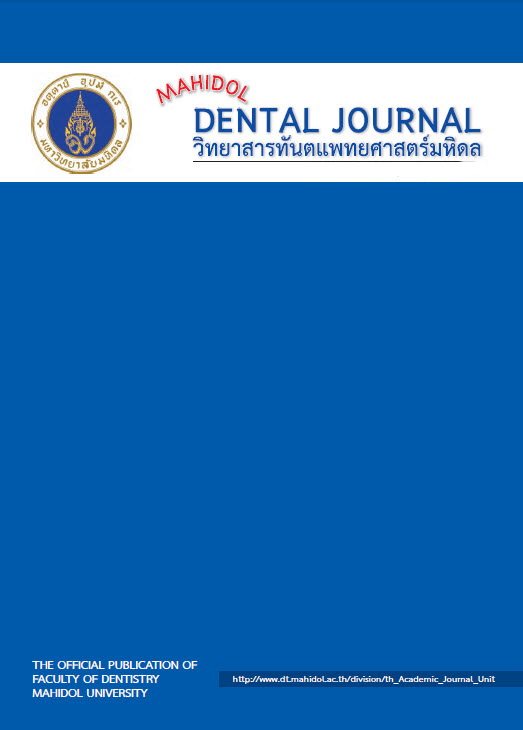Effect of Curing Protocols on Degree of Conversion and Glass Transition Temperature of a Dual-cured Resin Cement
Main Article Content
Abstract
Objective: The objective of this study was to investigate the effect of light-curing protocols on degree of conversion (DC) and glass transition temperature (Tg) of a dual-cured resin cement (Variolink N). The correlation between DC and Tg was further investigated.
Materials and methods: Different light-curing protocols (no irradiation, irradiation with light tip directly contact to specimen, and irradiation with light tip positioned at 10 mm from specimen) were used in-order to investigate the influence of energy density (ED) on DC and Tg of the resin cement. 15 and 45 specimens of mixed cement were prepared for DC and Tg observation respectively, then subjected to irradiating protocols underneath a ceramic block (10 mm length x 10 mm width x 0.95 mm thickness) and light cure for 40 sec in light curing groups. DC was measured by Raman microspectroscopy and Tg was measured by differential scanning calorimetry at 5 min, 15 min and 24 hrs after post-polymerization. Data were submitted to two-way ANOVA. The DC and Tg data were subjected to linear regression analysis.
Results: Increasing of distance between light tip and specimens decreased ED. Curing protocols with different ED influenced DC (p<0.01) and Tg (p<0.01) of the cement. The increasing of ED significantly increased DC and Tg. The DC and Tg improved significantly with the extension of post-polymerization times up to 24 hrs. A significantly positive correlation was found between DC and Tg.
Conclusion: ED of curing light and post-polymerization times influenced DC and Tg of the dual-cured resin cement.
Article Details
References
2. Kwon TY, Bagheri R, Kim YK, Kim KH, Burrow MF. Cure mechanisms in materials for use in esthetic dentistry. J Investig Clin Dent. 2012; 3: 3-16.
3. Abedin F, Ye Q, Camarda K, Spencer P. Impact of light intensity on the polymerization kinetics and network structure of model hydrophobic and hydrophilic methacrylate based dental adhesive resin. J Biomed Mater Res B Appl Biomater. 2016; 104: 1666-78.
4. Dewaele M, Asmussen E, Peutzfeldt A, Munksgaard EC, Benetti AR, Finne G, et al. Influence of curing protocol on selected properties of light-curing polymers: degree of conversion, volume contraction, elastic modulus, and glass transition temperature. Dent Mater. 2009; 25: 1576-84.
5. Silikas N, Eliades G, Watts DC. Light intensity effects on resin-composite degree of conversion and shrinkage strain. Dent Mater. 2000; 16: 292-6.
6. Soh MS, Yap AU. Influence of curing modes on crosslink density in polymer structures. J Dent. 2004; 32: 321-6.
7. Pianelli C, Devaux J, Bebelman S, Leloup G. The micro-Raman spectroscopy, a useful tool to determine the degree of conversion of light-activated composite resins. J Biomed Mater Res. 1999; 48: 675-81.
8. Moraes RR, Boscato N, Jardim PS, Schneider LF. Dual and self-curing potential of self- adhesive resin cements as thin films. Oper Dent. 2011; 36: 635-42.
9. Asmussen E, Peutzfeldt A. Influence of pulse-delay curing on softening of polymer structures. J Dent Res. 2001; 80: 1570-3.
10. da Silva EM, Poskus LT, Guimaraes JG, de Araujo Lima Barcellos A, Fellows CE. Influence of light polymerization modes on degree of conversion and crosslink density of dental composites. J Mater Sci Mater Med. 2008; 19: 1027-32.
11. Lovell LG, Berchtold KA, Elliott JE, Lu H, Bowman CN. Understanding the kinetics and network formation of dimethacrylate dental resins. Polym. Adv. Technol. 2001; 12: 335-45.
12. Lovell LG, Lu H, Elliott JE, Stansbury JW, Bowman CN. The effect of cure rate on the mechanical properties of dental resins. Dent Mater. 2001; 17: 504-11.
13. Aguiar TR, Di Francescantonio M, Arrais CA, Ambrosano GM, Davanzo C, Giannini M. Influence of curing mode and time on degree of conversion of one conventional and two self-adhesive resin cements. Oper Dent. 2010; 35: 295-9.
14. Tezvergil-Mutluay A, Lassila LV, Vallittu PK. Degree of conversion of dual-cure luting resins light-polymerized through various materials. Acta Odontol Scand. 2007; 65: 201-5.
15. Arrais CA, Giannini M, Rueggeberg FA. Kinetic analysis of monomer conversion in auto- and dual-polymerizing modes of commercial resin luting cements. J Prosthet Dent. 2009; 101: 128-36.


